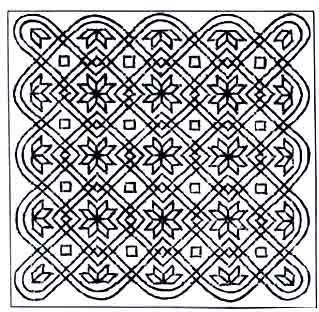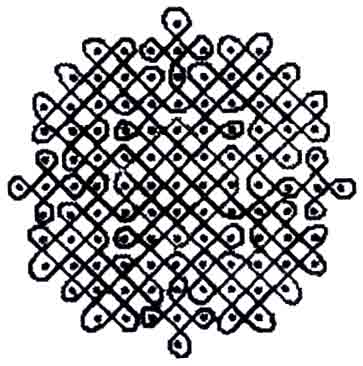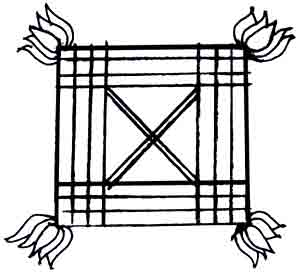


MARTHA STRAWN COLLECTION OF PHOTOGRAPHS OF ‘KOLAM’
Angkor flourished from the beginning of the 9th to the middle of the 4th century as political and cultural centre of Cambodia. I was a centre of Khmer artistic activity for over 500 years. Derived from the wordmagara in Sanskrit, Angkor is a sixteenth century momenclature of the Khmer capital and art styles which radiated from this centre. It was known as Yashodharapura in the Sanskrit inscriptions of Cambodia, named after its founder King Yasovarman (AD. 889-910). This was the first Yasodharapura or the first Angkor. Its centre was marked by a natural hill known as Phnom Bakheng. On the top of this hill, King Yasovarman built a Siva temple in the shape of a pyramid. The first Angkor was perhaps surrounded by the mud walls. Or it was an open city without any walls, as some archaeologists suggest.
The centre of the city of Yasodharapura/Angkor was shifted many times, but the name Yasodharapura was retained by Jayavarman VII (A.D. 1181-12220) who built a new walled city as the capital of Khmer empire. It is called Angkor Thom or Angkor the Great by the present-day Cambodians. But in the inscriptions of Jayavarman VII, it is known by the old name of Yasodharapura. Phnom Bakheng, the centre of the first Yasodharapura is outside the rampart of this 12th century Yasodharapura or Angkor Thom. The famous temple of Angkor Vat is also outside this walled city.
The temple compex of Bayon (the teme of the exhibition) marks the exact geometric cetnre of the city of Angkor Thom. Bayon is a modern Khmer compound word: ba is a prefix, denoting the masculine element;yon is a Khmer transformation of Sanskrit yantra. In some sort it is a virile yantra to safeguard the Cambodian kingdom.
Prof. Sachchidanand Sahai, world-renowned expert on South East Asia had taken photographs of this temple in his recetn visit. These were presented at an exhibition at IGNCA. This was the first time that these photographs were being shown in India. In all, 41 photographs were exhibited at the exhibition (April 25 to 30, 2003).
The monument occupies a horizontal rectangular are measuring 141X228 m. It is a complex of some 60 edifices, constructed on three principal levels and composed of towers and pavilions with linking galleries.
The Bayon is the most enigmatic piece of Khmer architecture known for its multiple towers carved with four colossal human faces. The exhibition took one inside the walled city of Angkor Thom, spread over 12 sq km and retained the attention to the central monument of the Bayon, focusing on the symbolism of the site, its bas reliefs and its face towers. The walled city of Angkor Thom can be entered through five gates; the four gates are in the four directions; an additional fifth gate is parallel to the eastern gate, leading to the royal palace.
As one reaches the southern gate of the walled city of Angkor Thom, the impressive four colossal faces can be seen above the entrance. The walled city is surrounded by a deep moat where ferocious crocdiles live in the hey days of the Angkor empire. On corssing the moat through a causeway to enter the gate of the walled city, one sees, on the left side of the causeway, 54 devas (godlings) represented as holding a nine-headed naga (serpent). On the right side of the causeway, a row of 54 asuras (demons) hold another nine-headed naga. The scene represents the churing of the ocean according to some scholars. Others believe that it is the representation of a rainbow. After admiring the beautiful devas and ferocious asuras, one walks inside the walled city for about two kilometers, before reching the main temple of the Bayon.
The Bayon can be entered through four axial gates, corresponding to the four gates of the city. Entering through the eastern gate, one can admire the bas reliefs depiciting depicting every day life and beautiful dancing figures. And then climbing the second and the third levels of the monument one finds oneself surrounded by four faced tall towers, co-lossal human faces saring from all sides. Many efforts have been made to count the number of towers with four human faces. According to one reckoning the towers with faces are as follows: 37 towers with 4 faces each (148 faces), 9 towers with 3 faces each (27 faces) and one tower with 2 faces (2 faces) – a total of 177 faces.
The famous nineteenth century French traveler, Pierred Loti found these faces “smiling down their flat noses, eyelids half-closed, with a kind of decrepit feminity.” These enigmatic faces have been variously identifies as Brahma, Shiva, Lokesvara or the Buddha Samantamukha. A Japenese team has been restoring this temple complex for the last ten years. Restoration and better knowledge of this central architectural piece would reveal many lost linkages about the past cultural ties between India and this part of South East Asia.
Member Secretary Prof. Indra Nath Choudhuri and Shri Raghuvansh Prasad Yadav, MP, inaugurated the exhibition. Shri Yadav pointed out that in Bihar there is a four-faced Shiva temple and wondered if the influence of such temple architecture had gone from India or vice versa. He said such exhibitions should be encourages as they gave an opportunity for people to learn more about inter-cultural influence without actually traveling to these places. Prof. Choudhry thanked Prof. Sahai for choosing IGNCA as the venue for unveiling his collection of photographs, for the first time in India.
[ Newsletter | List of Newsletter ]




